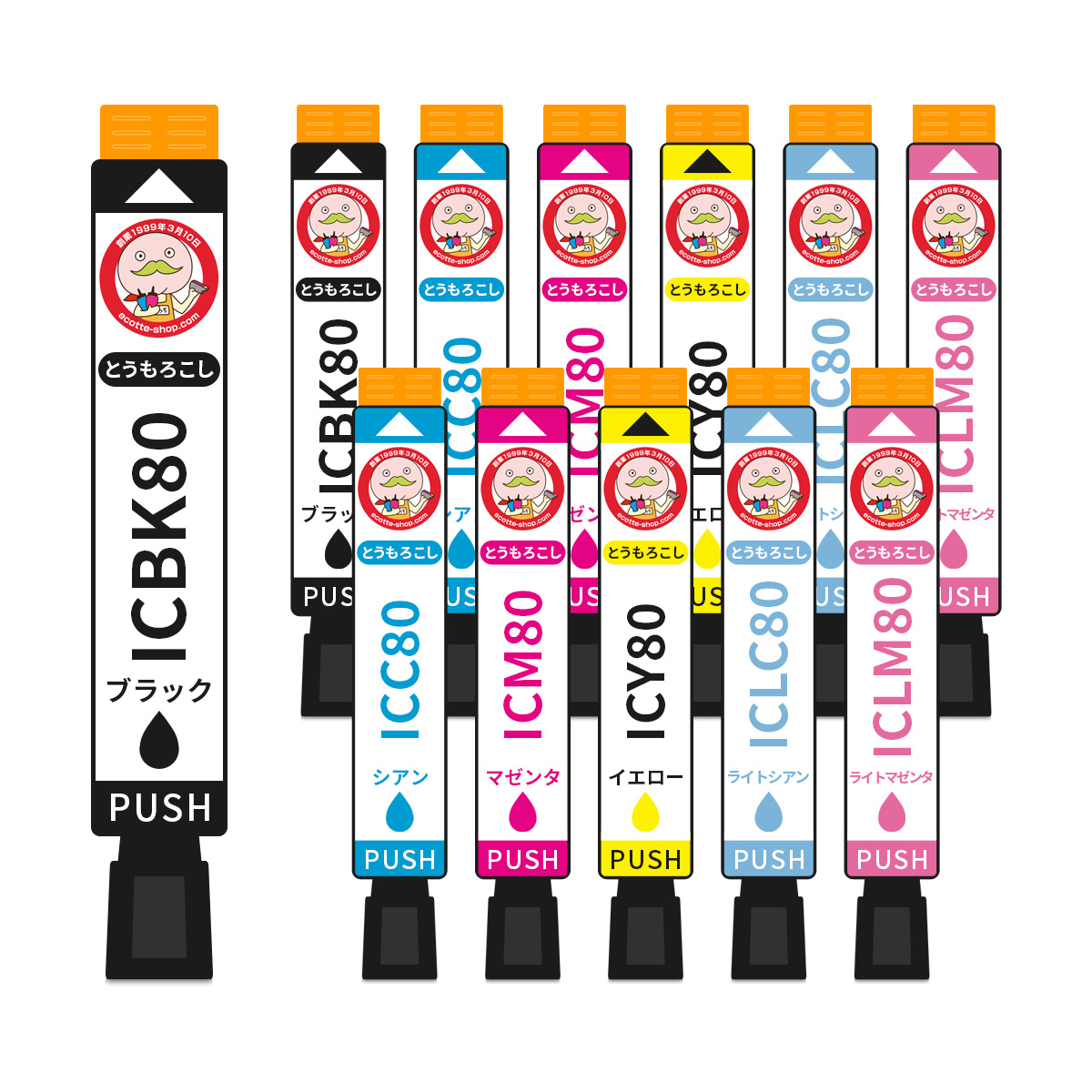エプソンプリンターインクカートリッジ
(税込) 送料込み
商品の説明
エプソンのインクカートリッジ、イエロー(純正)とブラック(互換)の2色セットです。
対応機種はそれぞれ以下の通りです。
●イエロー〈ICY80〉純正
純正インクカートリッジ|エプソンプリンター対応純正インク|IC80シリーズ純正インクカートリッジ
|純正インクカートリッジ|エプソン対応インク|IC80シリーズ|純正|
商品番号:ICY80
JANコード:4988617193963
色:イエロー
対応プリンター: / EP-707A / EP-708A / EP-777A / EP-807AB / EP-807AR / EP-807AW / EP-808AB / EP-808AR / EP-808AW / EP-907F / EP-977A3 / EP-978A3 / EP-979A3 / EP-982A3 /
●ブラック〈BK80XL〉互換
対応メーカー:エプソン(EPSON)
対応型番:
ICBK80L (増量タイプ) ブラック
ICC80L (増量タイプ) シアン
ICM80L (増量タイプ) マゼンタ
ICY80L (増量タイプ) イエロー
ICLC80L (増量タイプ) ライトシアン
ICLM80L (増量タイプ) ライトマゼンタ
対応機種:
EP-707A,EP-777A,
EP-807AB,EP-807AR,
EP-807AW,EP-907F,
EP-977A3,EP-808AW,
EP-808AB,EP-808AR,
EP-808AW,EP-907F,
EP-977A3,EP-978A3,
EP-979A3, EP-982A3,
※注意事項
純正インクと同じようにセットで簡単に使用可能ですが、純正ではありませんので、本品の使用によるプリンターの故障などの責任については負いかねます。商品の情報
| カテゴリー | 家電・スマホ・カメラ > 生活家電 > 電子レンジ/オーブン |
|---|---|
| ブランド | エプソン |
| 商品の状態 | 新品、未使用 |

エプソン 純正 インクカートリッジ 風船 ICBK50 ブラック

エプソン純正インクカートリッジ EPSON増量タイプ ICBK80L ブラック(大

エプソン インクカートリッジ IC6CL70L エプソン プリンターインク 6色

楽天市場】【送料無料】 エプソンプリンター用 インク 6色【2個セット

エプソン インクカートリッジ ICBK80L エプソン プリンターインク

楽天市場】【送料無料】 エプソンプリンター用 インク 6色【3個セット

よくある質問(FAQ)|エプソン | プリンター対応インク一覧<カラリオ

エプソン 純正 インクカートリッジ カメ KAM-6CL-L 6色パック 増量

エプソン純正】プリンターインクの特徴|1枚あたりのインク代は
エプソン プリンターインク ITH-6CL イチョウ ITH6cl 6色セット EPSON

楽天市場】エプソンプリンター用 互換インク IC6CL50 ICチップ有(残量

楽天市場】【送料無料】 エプソンプリンター用 インク RDH 4色セット

エプソン プリンター 用 互換インク KUI-BK-L 黒3本セット【ICチップ付】【 クマノミ EPSON プリンターインク 互換インクカートリッジ 】 (黒3本セット)《マケプレお急ぎ便》平日(月曜~土曜)14時までのご注文は当日出荷いたします/日曜祝祭日の出荷はお休みさせていただきます

エプソン、インクカートリッジで稼ぐプリンタービジネスから脱却を

から厳選した 新品 EPSON プリンター用インクカートリッジ 4色パック

Amazon.co.jp: エプソン プリンターインク IB07B マウス IB07CL4B 4色
エプソン プリンターインク MUG MUG-4CL 4色セット マグカップ MUG-BK

得価好評 エプソン EPSON 純正プリンターインク マットブラック 700ml

e-TREND|エプソン IB06CA [インクジェットプリンター用 インク

プリンターインク エプソン IB07B マウス IB07CL4B 4色パック×2セット 互換インクカートリッジ 対応プリンター PX-M6010F PX-M6011F PX-S6010 セット内容 IB07KB IB07CB IB07MB IB07YB 互換インク 純正 よりお得

エプソン純正プリンターインクカートリッジ 日本最大のブランド www

エプソンプリンター 純正インクカートリッジさくらんぼ70 L 6色+2色

EPSONプリンター純正インクカートリッジITH-LC、ITH-LM、ITH-C - 通販

インク | エプソンダイレクトショップ

限定製作】 【EPSON】エプソン プリンター インクカートリッジ

まとめ買いでお得 EPSON プリンターインク IC6CL80L 3箱セット PC周辺

絶品 エプソンプリンター用純正インク ecousarecycling.com
エプソン プリンターインク ITH-M×6 マゼンダ 赤 単品×6 イチョウ EPSON 互換インクカートリッジ EP-710A EP-711A EP-810A EP-811A EP-709A :eg-ith-m-6all:エコインク Yahoo!店 - 通販 - Yahoo!ショッピング

ITH-6CL 6色パック イチョウ ITH ICチップ装着式 互換インク

買取販売価格 エプソンプリンター PM-4000PX+インクカートリッジ24本

激安アウトレット!】 EPSON IC4CL6165 4色パック エプソン プリンター

限定モデル エプソン プリンターインク MUG-4CL マグカップ 4色自由

激安通販の エプソンプリンターインク とうもろこし zppsu.edu.ph

クラシカルレインボーハッピーバード エプソン大判プリンターインク

エプソンプリンター インク 76 純正 ×5+3 | www.jarussi.com.br

エプソン プリンターインクカートリッジセット タブレット | www.trabi.vn

SAT-6CL 6色セット + 黒1本 エプソン プリンター インク サツマイモ

EPSON プリンターインクセット | www.avredentor.com.br

入荷予定 EPSON プリンタージャンク品 インクカートリッジセット zppsu

注目の福袋!EPSONプリンター用インクセット 5個組 インクカートリッジ





商品の情報
メルカリ安心への取り組み
お金は事務局に支払われ、評価後に振り込まれます
出品者
スピード発送
この出品者は平均24時間以内に発送しています














